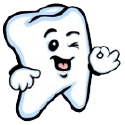What x-ray dose should be used for patients?
X-ray doses are relatively low for a single intra oral bitewing radiograph. This assumes that the x-ray equipment is properly maintained, radiation doses are measured, equipment is calibrated periodically (annually or biennially), and that film processing is carried out according to the film manufacturer's recommendations.
Concern about x-ray doses is significant for full-mouth surveys since the skin dose for these are similar to doses from CT head scans. This was emphasized by Brenner DJ and Hall EJ,, and Brenner DJ, et al. in the New England Journal of Medicine and AJR. While a single bitewing results in a patient entrance dose of about 200 mrad and a full mouth survey with 20 images will result in a dose of 4,000 mrad, or 4 rad, similar to a CT head scan. If four bitewings are taken annually from age 10 to age 70, the patient receives a lifetime entrance does of 48 rad, a significant radiation dose.
Also of concern is that dental x-ray imaging may start at a young age, when patients are more susceptible to cancer induction. Brenner, et al., estimated that the risk for a pediatric patient may be 10 times higher than for an adult. A pediatric patient has a long life ahead, thereby leaving more time for radiation induced cancer to develop. In addition, dental x-rays are often taken more frequently that CT scans, e.g. annually.
X-ray doses are relatively safe but it is essential to know what radiation doses are used, to minimize that patient dose, and to maximize the image quality!
See our FAQ's for more information on x-ray dose, your patients, and your staff.
